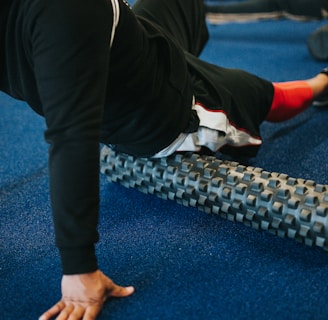Injury Prevention Strategies for New Powerlifters
Like any sport, powerlifting comes with its risks, and injury prevention should be a top priority. In this guide, we'll explore essential strategies to help new powerlifters minimize the risk of injuries and enjoy a safe and productive training experience.
Coach Mavrix
10/16/20233 min read


Injury Prevention Strategies for New Powerlifters
Starting your journey into powerlifting is an exciting endeavor that can transform not only your physique but also your overall strength and fitness. However, like any sport, powerlifting comes with its risks, and injury prevention should be a top priority. In this guide, we'll explore essential strategies to help new powerlifters minimize the risk of injuries and enjoy a safe and productive training experience.
1. Warm-Up and Mobility Work
A proper warm-up is a cornerstone of injury prevention in powerlifting. Before lifting heavy weights, spend time on dynamic stretching and mobility exercises to prepare your muscles and joints. Incorporate movements that target the muscles you'll be using in your workout, such as hip flexors, hamstrings, and shoulders as an example. Aim for at least 10-15 minutes of warm-up before your main lifts. You may be able to get away without warming up for a short period of time but trust me when I say it will catch up to you.
2. Technique Mastery
One of the most effective ways to prevent injuries in powerlifting is to master proper lifting technique. Focus on lifting with the correct form, as it reduces the stress on your joints and minimizes the risk of strain. Don't hesitate to seek guidance from an experienced coach or trainer who can provide feedback and corrections on your form. I'm more than happy to help guide you, You can contact me here if you're interested!
3. Gradual Progression
The principle of progressive overload is essential in powerlifting, but it should be applied cautiously. Avoid making huge leaps in weight or volume. Gradually increase the intensity and volume of your workouts to give your body time to adapt. Sudden, drastic changes in intensity are a common cause of injuries. I seriously cannot stress this enough. You would rather "sandbag" your lifts to a PR than make drastic jumps week to week and eke out a PR with a higher risk of injury.
4. Listen to Your Body
Your body will provide signals when something isn't right. Listen to it. If you experience persistent pain, discomfort, or unusual sensations during a lift, stop immediately. Ignoring these warning signs can lead to more severe injuries. It's far too common that powerlifters ignore the signals their bodies send them. If you feel pain inside the joints or feel generally sore and beat up each workout, that's your body telling you its recovery is not adequate for the demands placed upon it. The only exception is when you're peaking for a meet. Naturally, your body is going to feel extra beat up leading into a competition as your volume and load have reached a taper.
5. Rest and Recovery
Adequate rest and recovery are critical for injury prevention. Ensure you get enough sleep and allow your muscles to heal between workouts. Overtraining can lead to injuries and hinder your progress. Aim for at least 48 hours of rest between working the same muscle group.
6. Cross-Training
Incorporating other forms of exercise can help prevent overuse injuries and balance muscle development. Consider including flexibility training, cardio, or yoga in your routine to complement your powerlifting workouts.
7. Proper Nutrition and Hydration
A well-balanced diet with the right nutrients is essential for recovery and injury prevention. Make sure you're consuming enough protein, vitamins, and minerals. Staying well-hydrated is also crucial to prevent muscle cramps and maintain overall health.
In conclusion, injury prevention is a crucial aspect of a successful powerlifting journey. By implementing these strategies, you'll significantly reduce the risk of injuries and create a solid foundation for your strength training progress.
Sources:
1. Schoenfeld, B. J. (2010). "The use of nonsteroidal anti-inflammatory drugs for exercise-induced muscle damage: implications for skeletal muscle development." Sports Medicine, 40(12), 1089-1099.
2. Cook, G., Burton, L., & Hoogenboom, B. J. (2006). "Pre-participation screening: the use of fundamental movements as an assessment of function - part 1." North American Journal of Sports Physical Therapy: NAJSPT, 1(2), 62.
3. Simic, L., Sarabon, N., & Markovic, G. (2013). "Does pre-exercise static stretching inhibit maximal muscular performance? A meta-analytical review." Scandinavian Journal of Medicine & Science in Sports, 23(2), 131-148.
4. Drinkwater, E. J., Lawton, T. W., Lindsell, R. P., Pyne, D. B., Hunt, P. H., & McKenna, M. J. (2005). "Training leading to repetition failure enhances bench press strength gains in elite junior athletes." Journal of Strength and Conditioning Research, 19(2), 382-388.
5. National Strength and Conditioning Association (NSCA). (2008). "Strength and Conditioning Professional Standards and Guidelines." [https://www.nsca.com/contentassets/0eb3e2839a17427a85d75d2b1ab8a0dd/strength-and-conditioning-professional-standards-and-guidelines.pdf](https://www.nsca.com/contentassets/0eb3e2839a17427a85d75d2b1ab8a0dd/strength-and-conditioning-professional-standards-and-guidelines.pdf)


